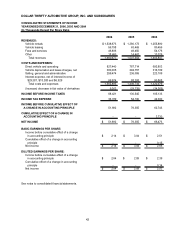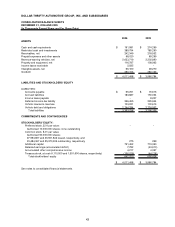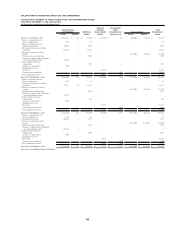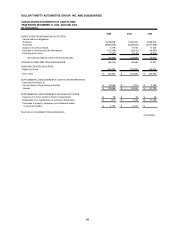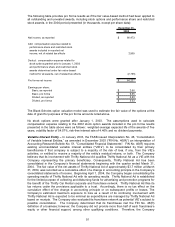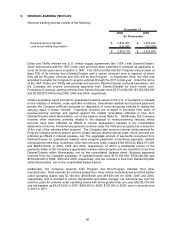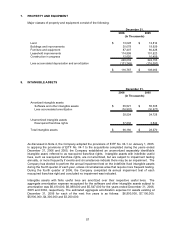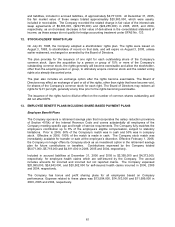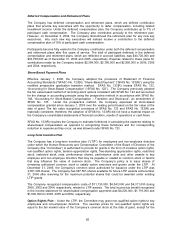Thrifty Car Rental 2006 Annual Report Download - page 58
Download and view the complete annual report
Please find page 58 of the 2006 Thrifty Car Rental annual report below. You can navigate through the pages in the report by either clicking on the pages listed below, or by using the keyword search tool below to find specific information within the annual report.believes that its franchisees do not qualify as VIE’s under FIN No. 46(R) and are not required to be
consolidated into the Company’s financial statements.
New Accounting Standards – As discussed in Note 13, in December 2004, the FASB issued
Statement of Financial Accounting Standards (“SFAS”) No. 123(R), “Share-Based Payment” (“SFAS
No.123(R)”), which eliminates the intrinsic value measurement method of accounting in Accounting
Principles Board Opinion No. 25, "Accounting for Stock Issued to Employees," and generally
requires measuring the cost of the employee services received in exchange for an award of equity
instruments based on the fair value of the award on the date of the grant. The standard requires
grant date fair value to be estimated using either an option-pricing model that is consistent with the
terms of the award or a market observed price, if such a price exists. Such costs must be
recognized over the period during which an employee is required to provide service in exchange for
the award. The standard also requires estimating the number of instruments that will ultimately be
issued, rather than accounting for forfeitures as they occur. The Company adopted the provisions of
SFAS No. 123(R) on January 1, 2006 using the “modified prospective” method. Under the “modified
prospective” method, compensation cost is recognized in the financial statements beginning with the
effective date, based on the requirements of SFAS No. 123(R) for all share-based payments granted
after that date, and based on the requirements of SFAS No. 123 for all unvested awards granted
prior to the effective date of SFAS No. 123(R). The Company had previously adopted the provisions
of SFAS No. 123, “Accounting for Stock-Based Compensation” (“SFAS No. 123”) beginning January
1, 2003 changing from the intrinsic value-based method to the fair value-based method of
accounting for stock-based compensation and electing the prospective treatment option, which
required recognition as compensation expense for all future employee awards granted, modified or
settled as allowed under SFAS No. 148, “Accounting for Stock-Based Compensation – Transition
and Disclosure,” an amendment of SFAS No. 123. Thus, the adoption of SFAS 123(R) did not have
a material effect on the consolidated financial statements of the Company.
Under SFAS No. 123, the Company used the closing market price of the Company’s common
shares on the date of grant to estimate the fair value of restricted stock and performance shares. No
options were granted after January 1, 2003; however, the Company utilized the Black-Scholes
option valuation model to estimate the fair value of the options at the date of grant for purposes of
pro forma disclosures. As discussed more fully in Note 13, upon adoption of SFAS No. 123(R), the
Company continued to utilize the closing market price of the Company’s common shares on the date
of grant to estimate the fair value of restricted stock and the performance based portion of
performance share awards. The Company began to utilize a lattice-based option valuation model to
estimate the fair value of the market condition based portion of performance share awards, as
management believes this model is more flexible than the Black-Scholes model, as it allows for
more estimated inputs that can be varied throughout the term of the award.
At December 31, 2006, the total compensation cost related to nonvested performance share awards
not yet recognized is estimated at approximately $9,100,000, depending upon the Company’s
performance against targets specified in the performance share agreement. This estimated
compensation cost is expected to be recognized over the weighted-average period of 1.7 years.
On November 10, 2005, the FASB issued FASB Staff Position (“FSP”) No. FAS 123(R)-3 “Transition
Election Related to Accounting for the Tax Effects of Share-Based Payment Awards” (“FSP No.
123(R)-3”). As discussed in Note 13, the Company adopted the alternative transition method
provided in FSP No. 123(R)-3 for calculating the tax effects of stock-based compensation pursuant
to SFAS No. 123(R) effective January 1, 2006. The alternative transition method allows the use of a
simplified method to establish the beginning balance of the additional paid-in capital pool (“APIC
pool”) related to the tax effects of stock-based compensation, and to determine the subsequent
impact on the APIC pool and consolidated statements of cash flows of the tax effects of stock-based
compensation awards that are outstanding upon adoption of SFAS No. 123(R). The adoption did not
have a material impact on the Company’s consolidated financial position or results of operations.
52


